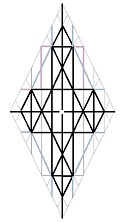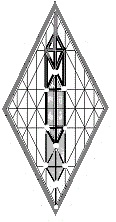Thoughts on God and Man
 Our la is
hla. la
is not the father, though God’s eternal divinity is the instigator of
all created things.
la is not the mother, though
la is the eternal well of
divinity from which all things originate.
la is not the son, though
la projects his essence into temporal realms to perform the works
of divinity. la
is not a spirit that is distinct or differentiated from some other
consortium of divinity; for
la, a formless unity, is the
source of holiness.
la
is la. There is no other, and any
attempt to define
myhla creates idols in our minds.
hla can be known, loved, and worshipped; but
la cannot be defined.
Our la is
hla. la
is not the father, though God’s eternal divinity is the instigator of
all created things.
la is not the mother, though
la is the eternal well of
divinity from which all things originate.
la is not the son, though
la projects his essence into temporal realms to perform the works
of divinity. la
is not a spirit that is distinct or differentiated from some other
consortium of divinity; for
la, a formless unity, is the
source of holiness.
la
is la. There is no other, and any
attempt to define
myhla creates idols in our minds.
hla can be known, loved, and worshipped; but
la cannot be defined.
In parables, the scriptures speak of differentiations within divinity,
such as father, Al Shaddai, and Lord of Hosts; but the distinctions
concern principles operative within a singularity, not discrete spirits
who, together, comprise the godhead or a structured commonwealth of
gods. “Elohim” is a collective plural that speaks of the attributes of
HaShem. The Elohim are faces of HaShem— his aspects, not his surrogates.
As creator, the great
I AM
has prepared each of us to fulfill many roles and functions in our lives
on earth: we are who we are when we are what we are, and we will be that
which we are becoming. Thus, we are made in the likeness of HaShem,
after his image.
The inward diversity we experience is effortless and operates within a
seamless profile that informs us of our essence. Our minds and emotions
change instantaneously and are fully ready to change again; we act, and
we react; but in all that we do or is done in us, we are one.
As created beings, we are specimens; but as Sons of Man, we are the
begotten children of HaShem; for we share the singular Breath of Life
passed down from Adam, the Son of God, unto each and every one of us.
When we descend from heaven for incarnation, we enter into the
 mystery
of life on earth through baptism in amnionic fluids. With our first gasp
of air, we become immersed in the Holy Breath that hides between the
phases of natural breathing, whose rhythms affirm that we have accepted
our mortal identities.
mystery
of life on earth through baptism in amnionic fluids. With our first gasp
of air, we become immersed in the Holy Breath that hides between the
phases of natural breathing, whose rhythms affirm that we have accepted
our mortal identities.
Immersed in the Breath, we live as though we are impaled within
it, even as it is embedded within us. Believer and non-believer alike,
we magnify HaShem; for by coming to earth, we became finite portals of
the infinite. Immortal worms of fire that descended to earth for
incarnation, we put on mortality to wear it out in the quest to regain
the immortality we
believe to be our right. This belief is
inexplicable, were it not for the visceral Presence that hides between
our breaths. When mortality has run its full course, we will come to
perfection and shall be clothed with the faces of HaShem.
 Just
as la is beyond definition by man,
he is also beyond being named by
Just
as la is beyond definition by man,
he is also beyond being named by
man. But because man would feel
need to address the Eternal One,
myhla
chose the Name
hwhy as the name of address for its oracular properties.
For my part, I trust that
hla
tolerates the traditional use of “HaShem
mch“ for purpose of informal address, because I’m fond of its poetic
properties, trusting also that HaShem will overlook my occasional use of
“God”; for we are to make no man an offender for a word.
The Name
hwhy speaks of the one who gives
y life h
and who sustains
w life
h. HaShem is cause
hy
and effect
hw;
both action hy and the counterbalancing
reaction hw. Interpretation of the
Name’s meanings must answer to the context in which it appears, as
codified in Torah by the anointed apostle Moshe
hcm, who was sent as the reflection of the Name
mch on earth, so that its reflection would prepare a people capable
of honoring its projection: namely, Mashiyach Yahushua
owcwhy, the shout
owc
of w
father Yah hy, as affirmed by Y’shua
ocwhy.
Each of us existed in the mind of
la
before the doors to heaven and earth materialized in answer to HaShem’s
word, at which moment father
hy
laid down his eternal life and godhead to be projected as
owcwhy into temporal realms. Yahushua is the father’s Shout
owc of HaShem's Vigor
why, the application of his
enunciated will, which is population of temporal realms with beings
capable of housing eternal spirit. To that end,
hla
lifts a remnant of every generation into congruence, the standard for
everlasting life.
Some argue that the etymology of Yahushua should render that name to
mean “the Cry (the sob)
owc of
w Yah hy,
an interpretation that disqualifies that name from consideration as the
name of HaMashiyach. This belief is supported by emotional notions they
and their fathers attached to its enunciation across millennia because
they don’t have ears to hear the ring of HaShem’s one-and-only battle
cry. Words are bodies of thoughts, and Yahushua is the “embodiment” of
HaShem’s thought His word is his garment, his logos, his reality as the
angel of the presence of HaShem.
As savior and deliverer of temporal realms, Yahushua HaMashiyach raced
through the firmament of the universe as it opened before him; and as
his feet lifted and fell within its vast expanse, we who followed were
dislodged in his wake and fell to ground as sparks raised by the
footfalls of his heels, becoming scattered throughout the temporal
realms of creation. Forgetting our origins, we also lost track of the
divine presence that sustains the
spark of
life
in us by the whisper of our names; and we fell, ever deeper, into a
darkness we could not understand or escape.
Disoriented by the hazy expanses of temporal realms, we became deluded
by specters and shadows we imagined in the half-light of our
perceptions, and we began thinking of
la as a strange,
unapproachable, exterior reality: a confusion by day and a terror by
night. Anticipating our weaknesses, HaShem determined from the beginning
of creation that he would dwell in the thick darkness of our hearts. We
may feel utterly lost, but our hearts are God’s footstool; and our lives
unfold in response to the warmth of his feet. Our minds are God’s
throne, and we share moments of great illumination in the pastures of
earth, even when pressed by heavy distractions of the temporal.
To resolve the confusion that envelops us in moments of doubt, we must
accept that la is already within us: even
if we have no workable conception of what that means. That simple step
of faith is a holy call upon the godhead to reveal its presence in times
and ways that are useful for our healing. Because
la
has always been with us as
lawnmo,
the hidden presence of HaMashiyach, we are pre-paired to hear Yahushua’s
silent voice as he arises within us, knocking upon our hearts, seeking
permission to be born again.
We are pre-schooled in the ways of divinity by our experiences in temporal realms. All things that are made— with their forms, their operations, and interactions— are parables concerning the astounding practicality of divinity. Of course, we can also search the scriptures for understanding because they testify of divinity, but they cannot lead us to God.
Only the call within our hearts in answer to the parable of la as father and son brings our la nearer. The scriptures record the parable, but to be effective, the parable must be lived. Only our acceptance that we are of God’s projection breaks down the partition raised by the confusion of incarnation. Only our willingness and agreement to walk in the steps of God’s projection brings us to Golgotha, the Mount of Salvation; for it is there we nail the temporal to the eternal and fully accept the process of redemption.
| Let there Be | ||
| site |
book |